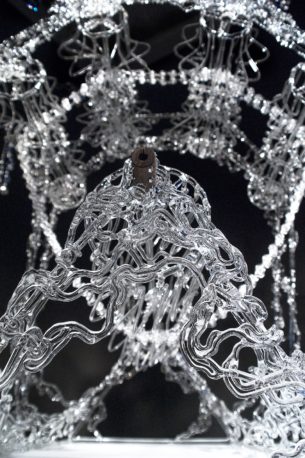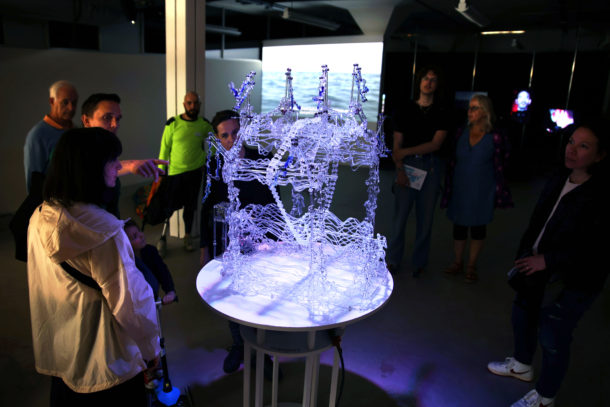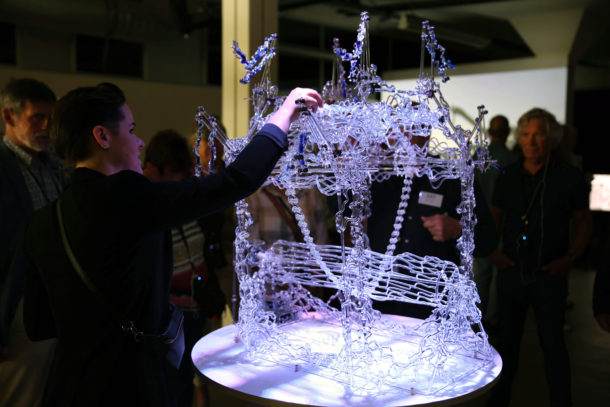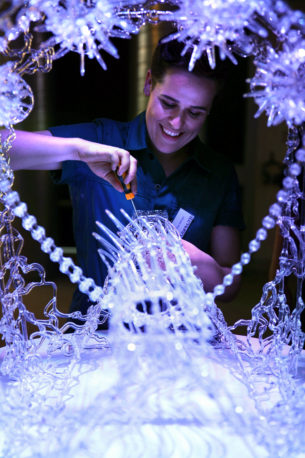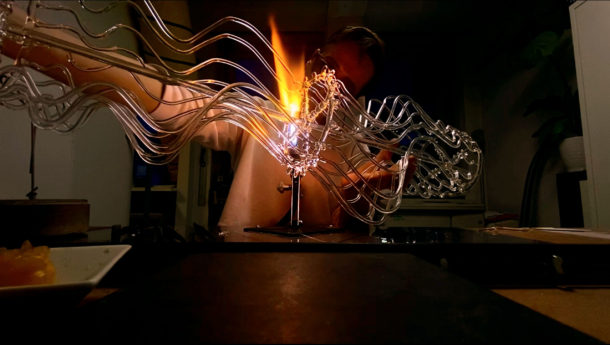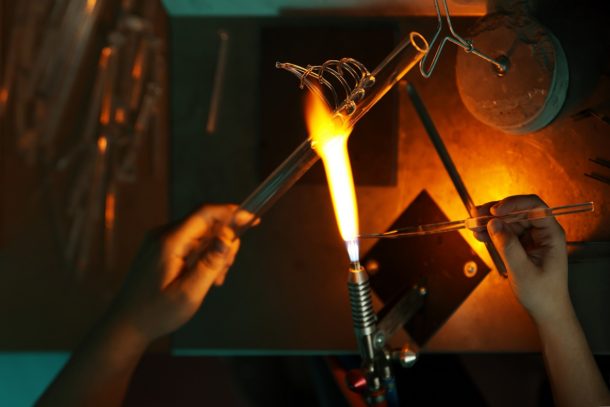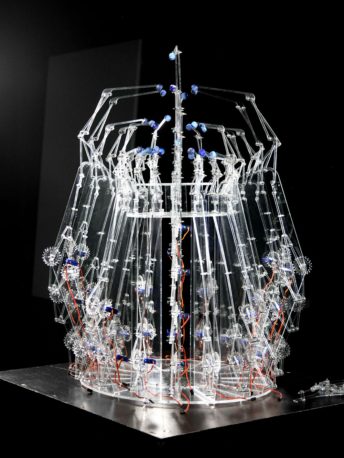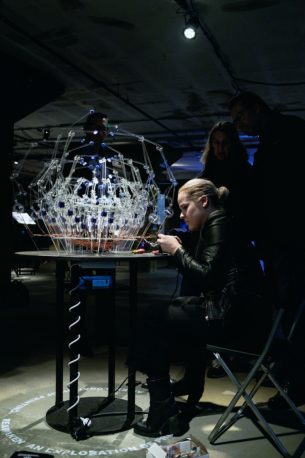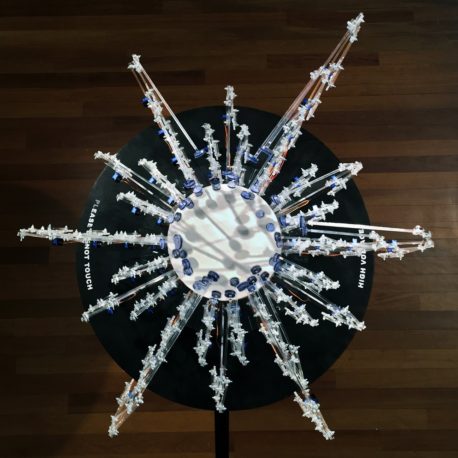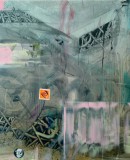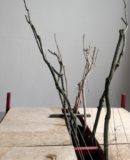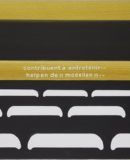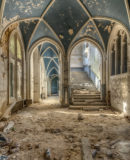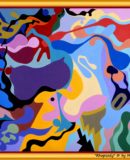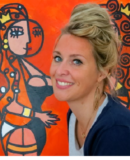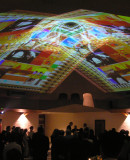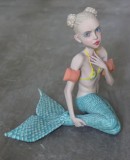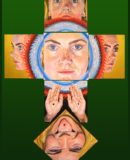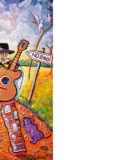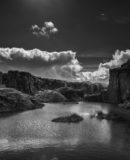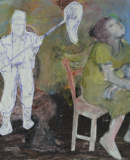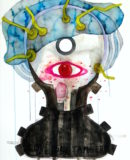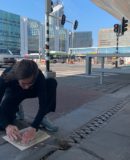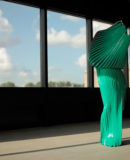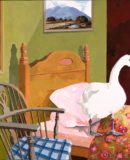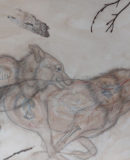World Fine Art Professionals and their Key-Pieces, 373 - Jeanine Verloop
World Fine Art Professionals and their Key-Pieces, 373 – Jeanine Verloop
In the Prospects program of Art Rotterdam 2022 I saw a young lady very carefully making small corrections to a beautiful glass work of art in a dark room. It looked beautiful, but fragile. Symbiote was the title of the artwork.
Its creator, Jeanine Verloop, was happy to provide some explanation about her work. In her kinetic sculptures she combines her love for craft with her fascination for technology, she says. “I want to make machines that look radically different, with looks that amaze, bring back a bit of magic and make people think about the purpose of the machine.”
Old printing machines and typewriters
During her illustration education at the Willem de Kooning Academy, she became interested in the technique of old printing machines and typewriters. “I immersed myself in their mechanisms and biological principles of movement. This became the starting point for a number of kinetic printing installations. Gradually, the machines themselves became more important than the prints they produce and became visualizations of my quest for imagination and beauty around technology.”
She notes the world around us is increasingly powered by invisible algorithms. “The devices around us often have the same tablet shape. Our living environment is so interwoven with technology that we no longer realize how much we consume on autopilot on a daily basis. I think it is very important to think about the impact of this and to reflect on the ways in which technology shapes our imagination. As Marshall McLuhan said in 1962, ‘We shape our tools and thereafter they shape us.’”
Our devices are designed in a way that we understand and our instincts tell us how to use them. “Although interesting, this results in large groups using and producing in the same way. The shapes of a device influence what the user produces, but also what the user imagines what the result could be.”
Making fictional machines real
Because of our connection to technology, we are strongly influenced by changes in the technological landscape, she continues. “Those changes can be relatively small, like our laptops no longer have a numeric keypad, or big, like an invisible algorithm learning from us on our social media. What comes up in my research is that we often fear, and have been afraid, that technology will one day surpass us. That distrust is not new. Peter Paul Verbeek, professor of Philosophy of Man and Technology at the University of Twente, describes how in the past people became afraid every time technology took a leap. Verbeek sees technology as part of us, in every historical timeline. “Technology determines how we are human and how we see the world. It always has done so, from the hand ax to the iPhone.’”
By making her fictional machines real, she hopes to combine technological and mystical qualities. “I want people to have a sense of inexplicable wonder when they see my work.”
Reawaken
In 2018 she wrote an abstract introduction for her work ‘Reawaken’. In it, she wonders how an alien would perceive us. “Maybe they think people and technology are part of the same entity?”
Imagine humanity through the eyes of aliens. Wouldn’t we look magical from space? From afar, humans seem to generate light and frequency. On closer inspection you would see that they actually have frail bodies, and they dominate their habitat through the use of tools.
Over time perhaps you could see the shift. The dawn of an industrialized civilisation. For a time humankind flourished in their mass-produced utopia. Great tools were built, of a scale easily visible from space. These creatures became enslaved to autimatisation. With no need for thinking, their brains grew weaker, and the magic of their tools got lost in utility.
How will they re-insert themselves and reconnect with their tools? Let us take a step back in time and space to obsolete technologies. Is there anything to be gained from resurrecting lost techniques?
Key work
Symbiote, her most recent work, is her key work. “It is almost entirely made up of borosilicate glass and was shown for the first time during Prospects, Art Rotterdam, May 2022. To make this work, I started studying Scientific Glassblowing in 2020. I wanted to delve into glass to emphasize and exaggerate the fragility of machines.”
Symbiote is a machine that seems to be destroying itself. “By controlling the stepper motor, the glass gears and glass chain threaten to get stuck in twisted shapes. If the work breaks completely, ink is released during this process, which is collected on a round plate on which the glass frame stands. This ‘imprint’ of the deconstruction, unlike the glass mechanism, will be permanent.”
Symbiote shows the beauty of technological constructions, but also their impending decay and eventual deconstruction. With this she wants to emphasize the ephemeral and fragile quality of technology. “For me there is a beauty in temporary existence. The work also only exists in close relationship with an assistant, in this case me. It wouldn’t work without me. Every time the work breaks, I’ll have to mend it. The work evolves, as do my skills.”
Dutch Design Week
In 2018 Jeanine Verloop graduated from the Willem de Koning Academy as an illustrator. “During my training I was already more concerned with making machines that produce prints than I was with the prints themselves. For me, the essence of illustration is not contained in the medium of drawing, but it is a way of telling stories and sharing information.”
After her training she has shown her first major kinetic work ‘Reawaken’ a lot. “Exhibiting my work helps me to develop new work. For example, by doing live repairs to a number of servo motors in front of the public during the presentation of Reawaken at Manifestations at the Dutch Design Week in 2018, I started thinking about my presence and the resulting actions that are needed to make the work function. Turning on the work causes some elements or gears to jump. The machine cannot fix these vulnerabilities on its own. In itself it is helpless.”
She realized that when the machine got broke —and she then repaired it—presented a performative potential. “I want to push this performance even further by replacing parts with an even more fragile material, namely glass. I think that glass may break due to friction and movement and I want to embrace it, because vulnerability is inherent in my work.”
Cognizant
In 2019 she spent two months as Artist in Residence at https://hangar.org/en/, where she developed and presented her work ‘Cognizant’ for the first time. This residency was made possible by https://v2.nl/ For The Unstable Media.
In 2020, she received the Young Talent Work Grant (Mondriaan Fund) and the Startup Grant for Research on Scientific Glass Blowing (Creative Industry Stimulation Fund). “Through this financing, I also had the opportunity to invest time in my practice and purchase tools and materials during the first lock downs.”
She is self-taught in the field of glass. “To learn some basics, I mapped out a learning path based on books and watching videos of glass workers at work. With the help of equipment from Iris Roskam, who herself worked as a glass blower, I took my first steps on the burner in May 2020.”
Glass blowing
In September 2020 she attended a two-day workshop in borosilicate glass processing, given by Jörg Hanowski at the Stipglas location in Tilburg. “I was able to learn a lot and ask questions here, after the workshop I felt confident enough to set up my own workplace. These first steps were certainly not great. But as Bernard Bolas describes in A Handbook of Laboratory Glass-Blowing, “Until the student can steadily rotate a tube without thinking about it, real progress in glassblowing is impossible.” Eventually I let go of the books and started practicing a lot. I filmed these exercises to look back on later on what I needed to improve. I recorded the progress I made in the first year online at https://progress.jannetjejeanine.nl/nl/, a visual diary.”
At the invitation of Highlight Delft, she stayed in the Student Hotel in Delft in June 2021 to further develop her skills in glass. “This meant that I temporarily moved my glass workspace to the Student Hotel. It turned out to be relatively easy to move my workplace, which is not surprising when you consider the itinerant historical nature of glassblowing behind the burner. During my residency, the public could physically visit me in my temporary studio.”
As an artist, she is happiest practicing and developing her skills. “For me, that process will probably never be finished, there is always something to improve and learn that will take my work to the next level. At the moment I have started a study ‘Raspberry Pi Programming’ at the NHA (Dutch Trade Academy) because I want to investigate how I can manipulate the input for control in different ways.”
Philosophy
When asked about her philosophy, she says: “I am inspired by mechanical and biological principles of movement. For example, I collect outdated printers and various other electronic devices. I disassemble the devices to study different parts, with these ‘autopsies’ I increase my knowledge and I am inspired by this. One of my findings is that opening these devices shows how history isn’t linear, it hasn’t ‘been’. Old technologies lie beneath the surface and serve as building blocks for modern developments.”
As a multidisciplinary maker, she enjoys the freedom to combine the precision of the tools of digital fabrication with the tactility of traditional tools, she says. “William Morris, in his utopian novel News from Nowhere, writes of the ‘desire for beauty’ awakening in the minds of those no longer tied to the production line. For me, the blurred boundaries between craft, art and technology promise a similar brilliance. This combination creates crossovers with hybrid shapes and new possibilities. My research comfortably places ‘motion sensor’ and ‘laser cutting’ next to ‘burner’ and ‘annealing furnace’. Common terms for contemporary craft.”
Images
1 – 2) Symbiote, 2021, own photo Jeanine, Schieblock – atelier Rotterdam, 3 – 4) Symbiote during Prospects, May 2022, photo Rosanne van Batenburg, Van Nelle Fabriek Rotterdam, 5) development Symbiote, 2021, own photo Jeanine, Schieblock – atelier Rotterdam, 6 – 7) Development of Scientific Glassblowing, 2021, photo Rosanne van Batenburg, Benthemstraat – atelier in Rotterdam, 8 – 9) Cognizant, 2019, own photo Jeanine, Hangar.org, Barcelona, 10) Reawaken, 2018, own photo Jeanine, Another Day in Paradise, gallery De Meerse, Hoofddorp
jannetje jeaninehttps://www.instagram.com/jannetje.jeanine/https://www.facebook.com/jannetjejeanine/ https://ifthenisnow.eu/nl/verhalen/de-wereld-van-de-rotterdamse-kunstenaar-58-jeanine-verloop
Disclaimer: The views, opinions and positions expressed within this guest article are those of the author Walter van Teeffelen alone and do not represent those of the Marbella Marbella website. The accuracy, completeness and validity of any statements made within this article are not guaranteed. We accept no liability for any errors, omissions or representations. The copyright of this content belongs to Walter van Teeffelen and any liability with regards to infringement of intellectual property rights remains with the author.


